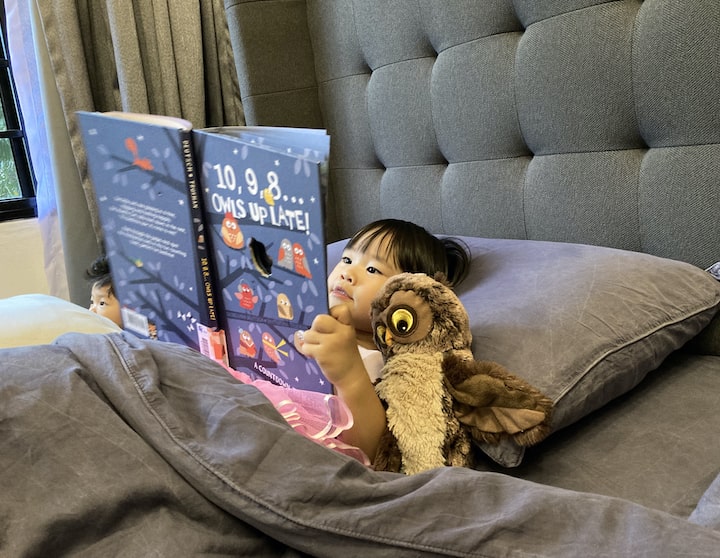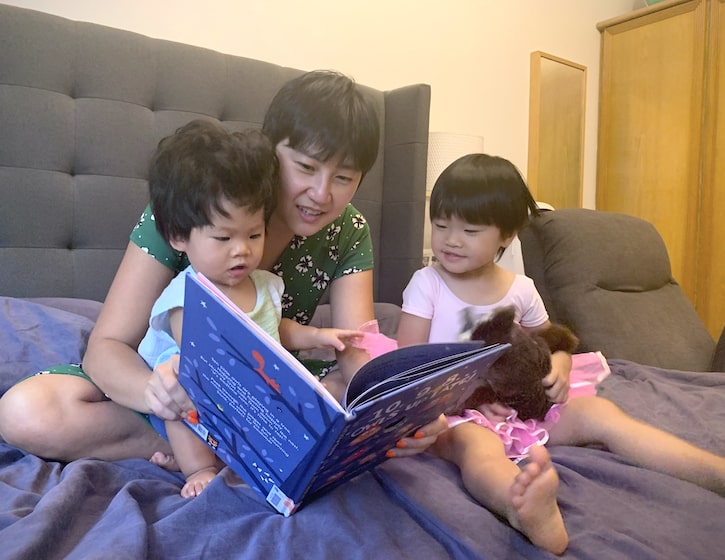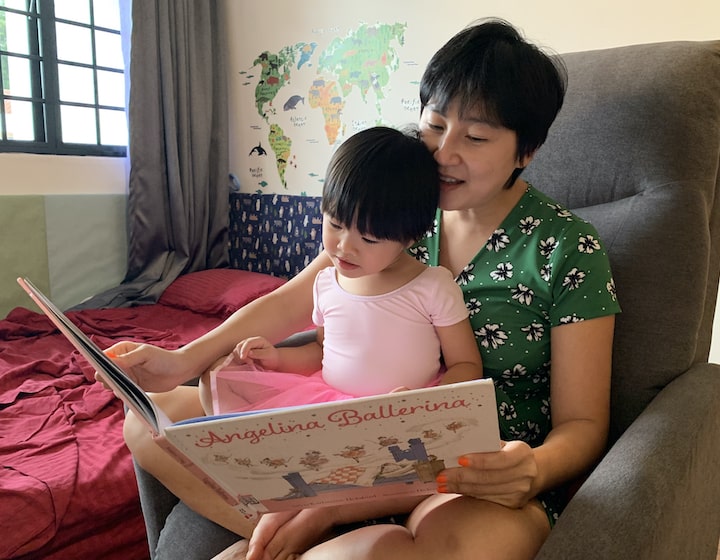
 Post Category - ParentingParenting - Post Category - Toddler & PreschoolerToddler & Preschooler - Post Category - Older KidsOlder Kids
Post Category - ParentingParenting - Post Category - Toddler & PreschoolerToddler & Preschooler - Post Category - Older KidsOlder KidsThese super practical tried and tested tips should help your child (both older kids and younger ones) develop a love for books no matter their current reading level
“How do I get him to read?” This was the most frequently asked question during parent-teacher meetings. I used to teach English and Literature in secondary schools. Now, I’m a part-time writer and full-time mum to a toddler and a baby. Here are some techniques that I’ve tried and tested on my teen students and my own kids. I hope they will prove useful to you too!
1. Read yourself!
Parent: “How do I get him to read?”
Teacher: “Do you read?”
Parent: “Um…”
Young people are savvy. It doesn’t matter how many times we tell them to do something. They have to see us actually doing it ourselves to be convinced it is not a futile endeavour. Full disclosure: it’s easy for me to model genuine passion for English books, but demonstrating the same fervour for Mother Tongue is an uphill struggle. So I get it. We know the seemingly Sisyphean task is worthwhile though, so how can we show our children our own love of reading?
“Who has the time?” This was the refrain of many of the parents I met, and now that I have little terrors – I mean bundles of joy – of my own, I know what they mean. It takes me ages to get through any physical books because I can only crack them open when everyone has gone to bed on those rare nights that I have completed everything on the to-do list and still have juice in the tank.
But I cheat it in two ways. First, my husband and I leave the books that we are reading lying around where our kids will see them. One day, my two year old leafed through one of our books. A pause. Then, she pronounced in awestruck tones: “So many words.”
If your curious child asks what you are reading about, tell them. I recall a funny incident where Peppa Pig found Daddy Pig’s book, “The Wonderful World of Concrete”. Peppa insisted he read it to her. He was thrilled to bits about it, and it was the perfect bedtime story because it bored everyone else to sleep. It doesn’t matter what the book’s topic is; it’s actually more about sharing your enthusiasm. Even if your child doesn’t ask, you can volunteer this information, because you are just so excited about the content that you can’t keep it to yourself. Create a literature-rich environment at home and allow yourself to bubble over about your own literary interests. Your kids may roll their eyes at first, but I’ll bet anything they’ll gradually get intrigued and infected.
Second, devote time to reading with your child. If you have older kids, you could have a scheduled period when everyone sits around poring through their own stuff quietly without the distraction of devices. Or, it could be a read-aloud session. Obviously this works well with young children. The nightly bedtime story is a treasured routine in many families for good reason. However, I’ve found this to also be very helpful for older kids. I used to get the weakest students in my English class to stay back for half an hour after school to take turns reading aloud. I shared with them Roald Dahl, my favourite author because of his subversive humour. I would take a turn too, doing dramatic voices to model expressiveness and good pronunciation. Ostensibly, this was to prepare them for oral exams, but the real aim was to show them how reading could be fun and to give them quality time and attention. Care and concern from an adult – never underestimate the power and impact that can have on a young person.

2. Respect the reader
Take all pressures and expectations off reading. Approach it as a recreational activity, not a chore or a test where the child has to prove himself. Many parents asked me if it is important to get the child to read newspapers or books from the “canon”, like Shakespeare or Austen. My recommendation is to first let children develop positive associations of joy with reading. Do not force books on a child, as that will likely turn them against reading. Resist the temptation to use language that suggests failings like laziness or stupidity.
Books in shops and libraries are often classified by age, but it is important to figure out a child’s actual reading level and give them books that are appropriate, not too difficult. Reading is a skill and students are on a ladder. They need to climb up on their own to master the skill, rather than be parachuted in somewhere too high where they will struggle to hang on and then fall off. Attach no shame to starting on a lower rung. Encourage all efforts to climb. If your child has a learning disability such as dyslexia that legitimately makes reading hard, recognize that there are coping strategies. Look them up and try them out together with your child.
To figure out your child’s reading level, read a text with them and check with them how much they understood. A good rule of thumb is to pick books where they understand 98% of the words. So for every 50 words, there is one word that is new to them. If a learner can understand 98% of the words in a text, the remaining 2% of unknown vocabulary can be acquired quite painlessly, with the learner figuring out the meaning through the context. The text should be easy enough that they can get sucked in and learn new words without interrupting the flow.

3. Keep it relevant
Anticipate milestones in children’s lives such as starting school, having a new sibling, losing their baby teeth, the onset of puberty, and so on. Introducing them to books on such topics is a great way to show them how reading is relevant to their lives, and also to help ease the transition before the actual events occur.
Books can be used to generate excitement before an outing or to extend learning after an experience. For example, I brought my daughter to an SSO concert for children. I knew there would be a lot of waiting time between doing the pre-event test for Covid and waiting for the show to begin. So I brought along Usborne First Book About the Orchestra and read to her about the instruments she could expect to see and so on. After the show, I read the book with her again, bringing her attention to details such as how the musicians had been positioned in the same way as in the book. It has been weeks and she is still pretend-playing the violin and cello. I have no doubt that the book captured her imagination and helped create a lasting impression of what she saw and heard.
It helps to be aware of children’s interests and guide them towards books on those topics. I once taught a class comprised entirely of DSA athletes. Almost none of them would consider themselves avid readers, but when I tasked them to write a composition about sports, it became apparent that some had read extensively in very specific fields. I received fluent essays that would not be amiss if they had appeared in a sports column reporting the previous night’s football match, and one very touching story about the unexpected outcome of a 400m race. The descriptions were vivid because the students wrote from the heart, from a world they lived and breathed. There is no need to be snobbish about what your kids read, whether it’s comics or yet another dinosaur encyclopaedia. Indulge their interests because so long as they are reading, they are climbing higher and higher up the rungs of that ladder, which will inevitably branch out into other areas later.
Also, take note of authors and illustrators of books your kids have enjoyed and introduce your kids to other books by the same people, or books in a similar vein. My two year old stunned me one day by saying, “Mummy, is this book by the same writer as Fox’s Socks?” She is now routinely able to distinguish on her own which books are by the same author, and is bossy enough to turn to the back cover, point to the other books pictured and demand, “Mummy, can you borrow this one? And this one? Can you buy?” Happily, she has her own taste in books and a healthy appetite for them!
To begin with, you would supply your children with books, but the end goal is to get them to a point where they will seek them out themselves. “Teach a man to fish,” as the saying goes. Show them how you found those books and familiarize them with library skills like navigating the Dewey Decimal System.

4. Research
Yup, you gotta do your homework. How else are you going to cultivate your own reading habit (tip #1), find books that fit your child’s reading level (tip #2), and choose books that are going to be surefire hits with your kid (tip #3)? This stuff doesn’t happen by accident!
The work of browsing through many books, evaluating them based on numerous criteria tied to the desired learning outcomes, curating the eventual selection, and crafting learning activities based on the books – all this was the basic professional expectation of me when I was an English and Literature teacher. So I set the same expectations of myself when it comes to teaching my own kids. I know this is not realistic for many parents. That’s why we send our kids to schools to be taught by the pros!
However, if we take our kids’ literacy seriously, we shouldn’t shy away from ploughing in some effort and being intentional about the content and quality of writing we expose our kids to. Every book represents an opportunity to get them hooked on reading – or to repel them. We use our time so that we don’t waste theirs.
I hope these tips for rousing reluctant readers have been an enjoyable read and you feel better equipped to awaken the ardour of your latent book-lover!
Check out more of my tips on how to get your kids to read in my YouTube video here.






 View All
View All




 View All
View All









 View All
View All




